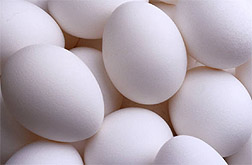This page has been archived and is being provided for reference purposes only. The page is no longer being updated, and therefore, links on the page may be invalid.
|
|
Egg Processing Plant Carts Can Harbor Bacteria
By Sharon DurhamDecember 18, 2009
Plywood-shelved carts that are used to transport eggs into processing plants can harbor Enterobacteriaceae, according to a microbial survey conducted by Agricultural Research Service (ARS) scientists in Athens, Ga.
Enterobacteriaceae, a bacterial family that includes the human pathogens Salmonella and Shigella, are known to contaminate the shell egg processing environment. High levels of these bacteria in the processing plant can signal inadequate sanitation.
However, little is known about the number of genera and species that contribute to contamination of what are called nest run carts. Eggs that are produced by hens not housed in buildings connected to the processing plant are called nest run eggs. These eggs are transported to the plant on the carts to be processed.
The results were part of a larger survey conducted in 2008. Swab samples were taken from two plants in the southeastern United States during three visits to determine location, bacterial profile and levels in the egg production line. Food technologists Michael Musgrove and Deana Jones in the ARS Egg Safety and Quality Research Unit at the Richard B. Russell Research Center in Athens found 100 percent prevalence for Enterobacteriaceae on nests run carts at one plant and 80 percent at the other. Species of Escherichia, Enterobacter, Klebsiella, and Salmonella, among others, were present. Pseudomonas was the only non- Enterobacteriaceae identified in the survey.
Each cart contained 15 unpainted plywood shelves. Musgrove and Jones took swab samples from the cart shelves and recovered a wide range of genera, but Escherichia and Enterobacter were present most often compared to other Enterobacteriaceae.
Knowing which bacteria are present and their location are vital pieces of information in developing strategies to reduce and remove bacterial contamination. The findings of this survey will be used by microbiologists working with the shell egg industry and regulators to encourage development of better sanitation procedures or the use of more easily-cleaned shelving materials.
This research was published in the Journal of Food Protection.
This research supports the U.S. Department of Agriculture (USDA) priority of ensuring food safety. ARS is USDA’s principal intramural scientific research agency.

